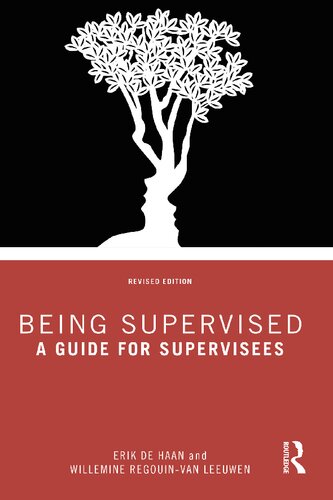

Most ebook files are in PDF format, so you can easily read them using various software such as Foxit Reader or directly on the Google Chrome browser.
Some ebook files are released by publishers in other formats such as .awz, .mobi, .epub, .fb2, etc. You may need to install specific software to read these formats on mobile/PC, such as Calibre.
Please read the tutorial at this link. https://ebooknice.com/page/post?id=faq
We offer FREE conversion to the popular formats you request; however, this may take some time. Therefore, right after payment, please email us, and we will try to provide the service as quickly as possible.
For some exceptional file formats or broken links (if any), please refrain from opening any disputes. Instead, email us first, and we will try to assist within a maximum of 6 hours.
EbookNice Team

Status:
Available4.5
13 reviews
ISBN-10 : 1032382201
ISBN-13 : 9781032382203
Author: Erik de Haan, Willemine Regouin-van Leeuwen
PART I Starting the supervisory journey
1 Why supervision?
1.1 Training
1.2 Practice
1.3 Supervision
1.3.1 Professional identity
1.3.2 Definition
2 Contracting: The way to monitor your progress
2.1 Contracting with the organisational sponsor
2.1.1 Supervision commissioned by a training or qualifying institution
2.1.2 Supervision commissioned by a professional care institution, clinic, or consultancy
2.1.3 Supervision commissioned by the supervisee
2.2 Contracting between supervisor and supervisee
2.2.1 Conditions
2.2.2 Objectives
2.3 Dealing with disappointment and mustering courage
2.3.1 Conflicts related to theoretical orientation
2.3.2 Conflicts related to supervision style
2.3.3 Conflicts due to disruption in the relationship and personality clashes
Notes
3 Learning in supervision
3.1 How do people learn in supervision?
3.1.1 Insight
3.1.2 Learning
3.1.3 Action
3.2 What should be learned in supervision?
3.2.1 Reflecting
3.2.2 Making experiences explicit
3.2.3 Problematising
3.2.4 Generalising
3.2.5 Finding learning objectives
3.2.6 Evaluating
3.3 Learning material in supervision
3.3.1 Reporting
Note
4 Reflective assignment
4.1 First focus on the kind of person you are
4.2 Focus on what you want to achieve through supervision
4.3 Focus on the broader outcomes of your supervision
PART II Being on the supervisory journey
5 The initial stage
5.1 Who are you both and how can you relate to each other?
5.1.1 Functional relationships
5.1.2 Getting to know each other
5.1.3 Boundaries
5.2 Who are you both and what can you do together?
5.2.1 Complications
5.2.2 Aligning expectations
5.3 What can you achieve and how?
5.3.1 Learning objectives
5.3.2 Methods
Note
6 The middle stage
6.1 Work in progress
6.1.1 Integration at the level of the person
6.1.2 Integration at the level of the profession
6.1.3 The supervisory relationship
6.1.4 Working together
6.1.5 The second account
6.2 The midterm review
6.2.1 Evaluation report
6.2.2 Evaluation session
6.3 Heading towards the end
6.3.1 Reflecting and the importance of language
6.3.2 Writing
7 The final stage
7.1 We’re nearly there
7.1.1 Supervision and practice
7.1.2 What the supervisee should be able to do
7.2 Final evaluation and optional assessment
7.2.1 Assessment
7.2.2 Value judgements
7.2.3 Evaluation and assessment in supervision
7.2.4 Perspective into the future
7.3 How do we go our separate ways?
7.3.1 Saying goodbye
8 The importance of writing in supervision
Work contributions are individually determined
8.1 Writing is essential in the helping professions
8.1.1 Note-taking during and after sessions
8.1.2 Contract and problem statement
8.1.3 Supervision reports and written opinions
8.2 Writing assignment
8.3 Example of a writing problem
Conclusion
Note
PART III Understanding the supervisory journey
9 The person
9.1 Thinking and knowing
9.1.1 Autonomy thinking
9.1.2 Heteronomy thinking
9.1.3 What is knowing and how do we acquire knowledge?
9.1.4 Logical thinking and reasoning
9.1.5 Sensible reasoning and argumentation
9.1.6 Critical attitude
9.2 Feeling, longing, and relating
9.2.1 Feelings
9.2.2 Motivation
9.2.3 Professional stance
9.2.4 Professional identity
9.2.5 Conclusion
9.3 Actions and skills
9.3.1 Actions and behaviour are not the same
9.3.2 The profession and professional requirements
9.3.3 Communication skills
9.3.4 Verbal communication: Questions and answers
9.3.5 Problematising work issues
Note
10 The profession
10.1 Professional theory: Thinking about the profession
10.1.1 Interaction between profession and training
10.1.2 Direction-setting views
10.1.3 Thinking about our place in society
10.1.4 Rationalism
10.1.5 Humanism
10.1.6 Crisis
10.1.7 Objectification
10.1.8 Diversity as an alternative?
10.1.9 A compromise
10.1.10 Conclusion
10.2 Professional practice: Working in the profession
10.2.1 Supervision and observation
10.2.2 Conceptualisation
10.2.3 Conceptualisation through language
10.2.4 The usefulness of conceptualising
10.2.5 Using a relationship
10.2.6 Helping relationships
10.2.7 Power and authority
10.3 A professional stance in the here and now
11 Links between person and profession
11.1 Professional socialisation
11.1.1 Forms of socialisation
11.1.2 Self-knowledge
11.2 Learning and facilitation of learning
11.2.1 Forms of learning
11.2.2 Concepts of learning
11.2.3 Autonomy learning
11.2.4 Heteronomy learning
11.2.5 Learning in supervision
11.2.6 Facilitated learning
11.2.7 Learning conditions and learning styles
11.3 Working and work support
11.3.1 Continuing professional development (CPD)
11.3.2 Peer consultation or action learning
11.3.3 Work support and learning
11.3.4 Practice supervision
11.3.5 Work supervision
11.3.6 Consultation
12 The importance of understanding in supervision
12.1 Self-understanding: A reflective assignment
12.2 Understanding yourself in your practice
12.3 Learning from the “here and now”
environmental politics a very short introduction
environmental politics at the local
environmental politics abbreviation
environment and planning politics and space
what is environmental politics
Tags: Being Supervised, Guide, Supervisees, Erik de Haan, Willemine Regouin van Leeuwen